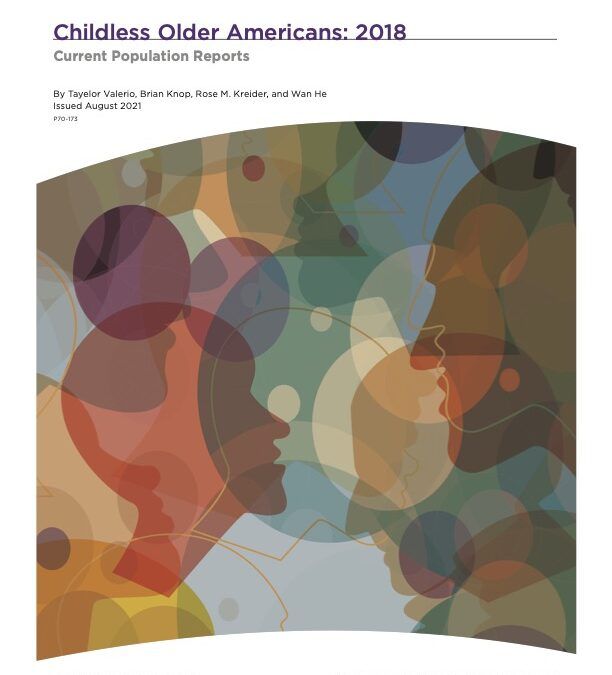11% of Older Americans (55+) are Childfree
Jay Zigmont, PhD, CFP®

TLDR: In Americans 55 and older; 11% Childfree, Childfree are more likely to never marry (32.1% vs 2.6%) and Childfree Women have the highest net worth ($173,800).
There always seems to be a debate about how many childfree people there are out there. Part of the reason is that much of the research looks at childless versus childfree. The US Census put out a report in August 2021: Childless Older Americans: 2018 that may have as good of an answer as we are going to find: https://www.census.gov/content/dam/Census/library/publications/2021/demo/p70-173.pdf
The report used data from the 2018 Survey of Income and Program Participation (SIPP) that asked questions about fertility (among many other issues. The census report looked at adults 55 and older who were childless (had no birth children) and found that “Of the 92.2 million older adults 55 years and older in 2018, 15.2 million (16.5 percent) are childless.” (p. 2) Keep in mind that this only reflects people who did not have biological children, and the SIPP report found “that 12.8 percent of childless adults 55 years and older have step or adopted children and no biological children, but cannot distinguish between those with stepchildren and those with adopted children.” (p. 1)
So their finding of 16.5 percent are childless does not reflect childfree as we would consider them. If the definition of childfree is someone that does not have children (biological, adopted, or step), we must do a bit more analysis. The study goes on to look at household composition which may give us our answer. The report states: “Of particular concern to policymakers may be the 3.9 million older adults who live with a spouse or partner, but neither they nor their partner have biological children.” (p.9) Let’s ignore the ‘concern’ for a minute, but if you add the 3.9 million to the 6.114 million that live alone (table 4), we get the closest answer towards a childfree population: approximately 10 million. There is a chance that those that live alone have adopted or step-children, but there isn’t enough data provided to judge further.
Assuming a population of 10 million childfree individuals (over 55, in the US), out of the total population of 92.2 million, we get 10.84% are childfree (11% if you round up).
Other studies and sites are often mentioned which say 15% are childless but these studies again look at childless people.
If we accept that childless as a group can be a proxy for childfree (it isn’t exact, but the similarities are strong), the report provides a few other important data points to understand:
- “Men are more likely to be childless at the age of 55 and older than women—18.2 percent of older men are childless, compared to 15.0 percent of older women”. (p.2)
- “Childless adults, as a group, are more educated than parents. About 38 percent of childless adults have at least a bachelor’s degree, compared to 30.0 percent of parents. (p.3)
- “a greater share of childless adults 55 years and older are currently in the labor force—about 44 percent of them are in the labor force, compared to 40.1 percent of parents.” (p.3)
- “90 percent (92.6) of older adults have ever been married, but childless adults are less likely to have gotten married than biological parents only 67.9 percent of childless adults have ever been married, compared to 97.4 percent of parents.” (p.9)
- “The median personal net worth among all adults 55 years and older was $133,500 (Table 5). Personal net worth is highest among childless women ($173,800) and biological fathers ($161,200).” (p.10, not a significant difference between childless women and biological fathers)
- “Poverty rates are higher among childless older adults than they are among parents.” (p.10)
- “About 4 in 10 childless older adults live alone, compared to 2 in 10 parents.” (p.15)
The bottom line is there are quite a few differences between parents and childless. The report was designed to talk about the BINGO question of “who will take care of you when you are old”. I was surprised by the amount of childless people who are living alone (40.3%) but not so surprised by the amount that were never married (32.1%) (p.9).
The one thing I want to point out for anyone that asks the BINGO question is that there isn’t much difference in who gets financial support from family (childless 2.5%, parents 1.5%) and the bottom line is that you need to be able to support yourself, no matter if you have kids or not.
All emphasis/bold is mine, not the report, just calling it out for clarity.
Sign up to receive financial news, tips, and tricks, straight to your inbox.
Thank you!
Copyright © 2025
Childfree Wealth® testimonials were given by current clients. No Cash or non-cash compensation was provided for the testimonial. There are no material conflicts of interest between Childfree Wealth and the person giving the testimonial. Investment advisory services are offered through Childfree Wealth®, an SEC registered investment advisor. Registration does not imply a certain level of skill or training. All written content on this site is for information purposes only.
Childfree Wealth®, Childfree Wealth Specialist® and Childfree Trust® are registered trademarks of Childfree Wealth, LLC. CFP Board owns the marks CFP®, CERTIFIED FINANCIAL PLANNER®, and CFP® (with plaque design) in the U.S
Childfree Wealth®, Childfree Wealth Specialist® and Childfree Trust® are registered trademarks of Childfree Wealth, LLC. CFP Board owns the marks CFP®, CERTIFIED FINANCIAL PLANNER®, and CFP® (with plaque design) in the U.S
